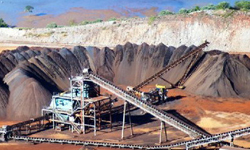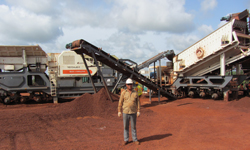Iron Ore Extraction Methods
Iron is mined almost exclusively in surface operations. The most predominant surface mining methods used to extract iron ore are open-pit and open-cut methods. The decision to employ underground or surface mining techniques is dependent on the proximity of the ore body to the surface. Underground mining methods, including caving and stopping, were commonly used to extract iron ores.
 Surface mining methods are designed to extract ore from surface deposits. Overburden, the soil and rock material that overlies the mine area, is removed to expose the ore deposit. The ore bench is drilled, blasted, and hauled to a plant for beneficiation. Overburden may be continually removed during the life of the mine as the highwall is cut back to permit deepening of the pit. Open-pit and open-cut mining are considered to be the least expensive extraction techniques.
Surface mining methods are designed to extract ore from surface deposits. Overburden, the soil and rock material that overlies the mine area, is removed to expose the ore deposit. The ore bench is drilled, blasted, and hauled to a plant for beneficiation. Overburden may be continually removed during the life of the mine as the highwall is cut back to permit deepening of the pit. Open-pit and open-cut mining are considered to be the least expensive extraction techniques.
Production drilling is conducted with mechanized drills, specific for each mining method. The chief objective of drilling operations is to create a hole of suitable diameter, depth, and direction in rock for explosives to be placed for blasting activities. At facilities operating in colder environments, salt brine may be added to drilling fluids to prevent freezing of the material in permanently frozen host rock.
The main requirement for an explosive to be used in mine blasting is the ability to achieve complete combustion without an external oxygen supply. In the past, explosives used in blasting were comprised of nitroglycerine, carbonaceous material, and an oxidizing agent. Today, the most common explosives used are mixtures of ammonium nitrate fertilizer and fuel oil. The explosive is detonated by a high-explosive blasting cap and/or primer. In other instances, emulsion or gel explosive cartridges may be used. The object of blasting is to expose the ore body for extraction or to create adits (horizontal passages) or shafts in rock formations that can be used to access the ore body during underground mining. Blasting is also used to break up ore in both surface and underground operations.
 The mining of taconite, a tough and abrasive low-grade ore (ranging from 40 to 60 percent silica and 17 to 30 percent iron) common to Minnesota and Michigan, is especially difficult because of the extreme hardness of the ore. Because of this hardness, additional drilling, blasting, crushing, and grinding are often required to extract the ore.
The mining of taconite, a tough and abrasive low-grade ore (ranging from 40 to 60 percent silica and 17 to 30 percent iron) common to Minnesota and Michigan, is especially difficult because of the extreme hardness of the ore. Because of this hardness, additional drilling, blasting, crushing, and grinding are often required to extract the ore.
Materials generated as a result of open-pit mining include overburden, waste rock, and mine water containing suspended solids and dissolved materials. Other wastes may include small quantities of oil and grease spilled during extraction. Mine water will contain dissolved or suspended constituents similar to those found in the ore body itself. These may include traces of aluminum, antimony, arsenic, beryllium, cadmium, chromium, copper, manganese, nickel, selenium, silver, sulfur, titanium, and zinc
For more information and technical support, please feel free to contact with kefid machinery company. More information about mineral ore mine extraction.

